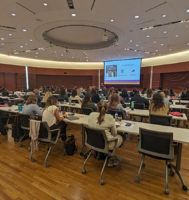Despite decades of research into the pathophysiology of hypoxic-ischemic brain injury and neuroprotection, effective therapy remains elusive and our clinical role after such an injury is largely supportive. More frustrating is the number of promising therapies that are effective in cell culture and animal models, but have subsequently failed to demonstrate benefit in clinical trials. The heterogeneity of injury and physiology, and the uncertain therapeutic window, are barriers to the translation of neuroprotective interventions. Additionally, pediatric brain injury studies must account for age related differences in cerebro-vascular physiology and susceptibility to brain ischemia, requiring prohibitively large multicenter trials to assess clinical benefit.
In an effort to overcome these barriers to translating neuroprotective interventions, we use small animal MRI to identify biomarkers of injury and therapeutic effect in animal models of pediatric cerebral ischemia. A combination of real-time imaging, conventional longitudinal imaging, and rodent behavioral testing is used to comprehensively assess neurodevelopmental differences in the physiology of ischemia and reperfusion, and the response to neuroprotective interventions. We have worked closely with the Sun Lab on their investigation into the role of the sodium/ hydrogen membrane ion exchanger (NHE1) in cerebral ischemia. We recently used T2 and Diffusion Weighted MRI to establish that genetic and chemical inhibition of NHE1 is neuroprotective in a mouse model of transient focal cerebral ischemia. Additionally, this work suggests that the size of the lesion seen on Diffusion Weighted images may be used as a biomarker of neuroprotection as early as one hour after reperfusion.
By identifying MRI biomarkers in animal models of pediatric brain injury, we hope to provide a means for selecting the patients most likely to benefit from a particular neuroprotective intervention in subsequent clinical trials. Basing patient selection on the physiologic target of therapy rather than simply the disease state will reduce the sample size needed, increase the likelihood of observing a drug effect, and facilitate the translation of promising neuroprotective interventions into clinical use.
Research News

Pediatric Brain Care Clinic’s multidisciplinary staff addresses acquired brain injuries from a wide range of causes
Every Thursday afternoon, the Pediatric Brain Care Clinic is open in the Waisman Center to see pediatric patients with acquired brain injuries, many recently discharged from time spent in the American Family Children’s Hospital (AFCH). …
March 12, 2025
UW Department of Pediatrics hosts MSPR 2024 meeting in Madison
The Midwest Society for Pediatric Research (MSPR) held its 2024 Annual Scientific Meeting in Madison, Wisconsin, September 18–20. Each year, the conference highlights innovative scientific discoveries and provides a space for collaboration and career development. …
November 7, 2024
Peter Ferrazzano and Claire O’Leary receive support from Research Forward awards
Two members of the Department of Pediatrics are part of multidisciplinary research teams that received funding through Research Forward. This initiative aims to stimulate and support highly innovative and groundbreaking research at UW–Madison. Research Forward …
August 19, 2024
Division of Critical Care hosts Pediatric Critical Care Regional Meeting
On May 22, the Division of Critical Care hosted the Pediatric Critical Care Regional Meeting at the Discovery Building on the UW–Madison campus. About 115 people attended the event, which is a collaborative effort of …
July 8, 2024
Three department members honored with named professorships at the inaugural SMPH Faculty Investiture Ceremony
Named professorships endowed by donors to the University of Wisconsin School of Medicine and Public Health (SMPH) convey both an honor and funds to recipients’ research and other endeavors. On October 12, at the Fluno …
November 2, 2022- More News...

Professor (CHS)
Division Chief, Critical Care